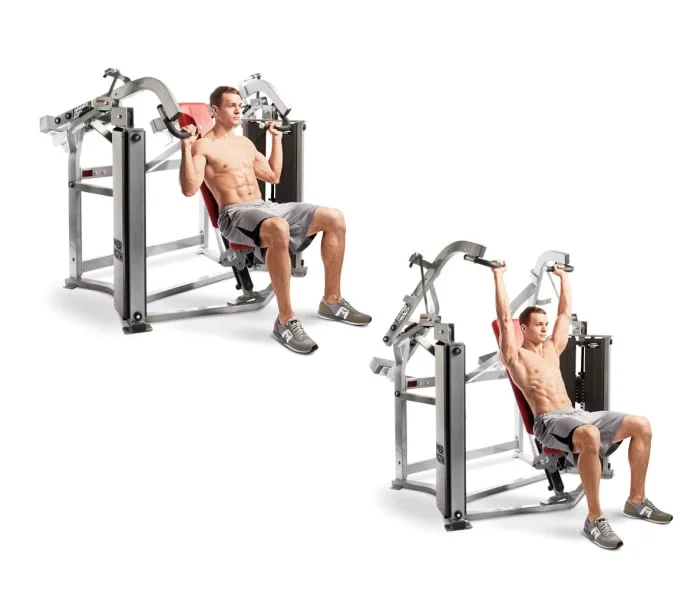The shoulder press machine is a staple in many gyms. If used correctly, it builds strength in your shoulders, supports joint health, and helps with posture and functional movement. But like any exercise, doing it poorly or overdoing it can lead to injury. Below are six major angles to understand the shoulder press machine fully: what it is, how to use it, what muscles it works, benefits vs drawbacks, common mistakes & how to avoid them, and programming tips to use it effectively.
What Is the Shoulder Press Machine?
The shoulder press machine is a piece of gym equipment (often seated) that allows you to press handles or a bar overhead in a guided, fixed path. It mimics the overhead press/lift (sometimes called overhead or military press) but adds more structural support.
Key features:
-
Fixed plane of motion: The machine guides your arms along a predetermined path, reducing the need for stabilizer muscles to hold balance.
-
Seat with back support: Usually has a backrest to support your spine, which helps limit unnecessary arching.
-
Adjustable handles and seat height: To align the start position with your shoulder joint so that the handles are at about shoulder level.
The machine version is particularly good for beginners, those recovering from injury, or people who want to isolate the shoulders without worrying too much about balance or coordination.
How To Use the Shoulder Press Machine: Proper Form & Technique
Using the shoulder press machine safely and effectively depends on good setup and precise execution. Poor form reduces benefit and increases risk. Here are detailed steps plus technique tips:
Adjust the seat height
Set the seat so the handles are at or slightly below shoulder height when your arms are bent. Your elbows should be at about shoulder level — not too high (which can cause strain) and not too low.
Sit correctly with proper posture
- Back firmly against the support pad.
- Feet flat on the floor, hip-width apart.
- Maintain a neutral spine; avoid arching your lower back. Engage your core to stabilize your torso.
Grip the handles properly
Hands should be roughly shoulder-width apart, palms facing forward (or per the machine’s design). Wrists should stay in line with forearms. Avoid letting wrists bend or sag.
Perform the press
Press upwards in a controlled motion. Extend arms nearly straight — but don’t forcefully lock out your elbows, because full lockout can stress joints. At the top, ideally the arms are overhead or slightly forward depending on machine design.
Lower with control
Don’t let the weight drop; bring handles down in a controlled motion toward shoulder level. Maintain stability. This eccentric portion is as important for muscle activation and safety as the concentric (lifting) part.
Breathing
Inhale as you lower, exhale as you push up. Keeping breathing steady can help maintain core stability.
Technique variations / adjustments:
- If you feel discomfort in the rotator cuff, adjust the angle: slightly in front of your body rather than directly lateral or behind neck.
- Ensure shoulders are depressed (pulled down) and back, not rounded forward or shrugged.
What Muscles the Shoulder Press Machine Works
Knowing which muscles are targeted helps you understand where strength gains will come and where to balance.
Primary muscles:
- Deltoids, especially anterior deltoid (front) and medial deltoid (middle). The machine press emphasizes those most.
- Triceps: As you extend the arms overhead, the triceps help with elbow extension.
Secondary muscles and stabilizers:
- Upper chest (clavicular pectoralis major) — assists in the pressing motion, particularly at the bottom phase.
- Trapezius (upper fibers) — helps stabilize the shoulder girdle.
- Core muscles (abdominals, lower back) — especially when seated without back support; they help control posture. Machine versions reduce the demand a bit, but still helpful to engage.
Benefits vs Drawbacks of the Shoulder Press Machine
As with any exercise modality, the shoulder press machine has trade-offs. Knowing both sides helps you integrate it effectively in your training.
Benefits:
- Safety and stability: The machine supports your back and guides the path of motion, which helps reduce risk of injury or misuse. Especially good for beginners or those with unstable shoulders.
- Isolation: Since stabilizing requirement is lower, you can focus more directly on working the shoulder muscles. Good for hypertrophy (muscle growth).
- Less fatigue from stabilizers: Because you don’t have to engage as many stabilizer muscles, the primary muscles can fatigue slower. That allows higher volume or sets.
- Consistent path helps technique: The fixed motion helps you maintain good form, minimizing jerky movements or risk from improper trajectory.
Drawbacks:
Limited stabilization work: You miss out on engaging stabilizer muscles as much, which could reduce overall shoulder girdle robustness. Free-weight pressing works more stabilizers.
Fixed path limits adaptability: The fixed motion may not match everyone’s natural joint anatomy, possibly causing discomfort or unnatural stress, especially if machine is poorly adjusted.
Potential for overloading joints: If you push too heavy or allow form to degrade (e.g. locking elbows, arching back), you can put strain on shoulders, rotator cuff, spine.
Less Functional for full-body integration: Because core and lower body involvement is reduced compared to standing press or free weights, the carryover to real-life movements may be lower.
Common Mistakes & How to Avoid Them
Even with the machine, mistakes are common. Here are typical errors and solutions:
| Mistake | Why It’s a Problem | Fix / How to Avoid |
|---|---|---|
| Seat too low or too high | Misalignment: handles start above or below shoulder level, causing strain on joint or reducing effective range of motion | Adjust seat so handles align with your mid-shoulder when elbows bent (about 90°). |
| Excessive lower back arching | Puts undue stress on lumbar spine; shifts load off shoulders | Brace core; ensure back pressed firmly against pad; avoid pushing chest too far up. |
| Locking out elbows forcefully | Puts stress on elbow joints and may compromise shoulder stability | Don’t lock elbow fully; leave a slight bend at top. |
| Using momentum (jerking or bouncing) | Reduces muscle activation; increases risk of injury | Lift and lower in controlled manner; pause briefly at top/bottom. |
| Shoulder shrugging / raising the shoulders | Overuses traps; reduces focus on deltoids; may compress structures near the collarbone | Depress shoulders (pull them down); focus on pushing through shoulders rather than shrugging. |
| Flared elbows too wide | Can cause shoulder impingement; puts more torque on shoulder joint | Keep elbows in a more forward or slightly in front alignment; avoid overly wide positions. |
Also avoid what is generally known as the behind-the-neck shoulder press on machines or otherwise: it forces a lot of external rotation and can stress rotator cuffs and shoulder joints.
Programming Tips: How to Include the Shoulder Press Machine in Your Workout
To maximize benefit and minimize risk, here’s how to program the shoulder press machine into your training plan:
Frequency: 1-2 times per week is usually sufficient, especially for well-trained individuals. Allow rest between sessions so shoulders can recover.
Sets & Reps: For strength: 3-5 sets of 4-8 reps with heavier weight (ensure form is solid). For hypertrophy: 3-4 sets of 8-15 reps. For muscular endurance: higher reps (15-20) with lighter loads.
Warm-up & mobility: Always begin with shoulder mobility drills, rotator cuff activation (external rotation, band pull-aparts), and warming up the upper back. Helps reduce risk of impingement.
Progress slowly: Increase weight gradually. Don’t sacrifice form just to lift heavier.
Use machine variety and free weights: Combine machine shoulder press with free-weight presses (dumbbells, barbells) and other shoulder movements (laterals, rear delts, face pulls) for balanced development.
Adjust grip & machine settings: If possible, change handle widths or angles to reduce joint discomfort and hit muscles differently. Some machines allow single-arm or alternating arm press which can help fix strength imbalances.
Why the Shoulder Press Machine Matters: Benefits for Strength, Fitness, and Longevity
Understanding the role of the shoulder press machine in a fitness plan shows why so many trainers and lifters include it. Here are broader reasons:
- Injury prevention: By allowing more controlled movement and less demand on stabilizer muscles, especially early on or during rehab, you can reduce risk of shoulder injuries.
- Progressive overload with safety: It offers a safer way to increase overhead strength progressively, particularly when you might not have a spotter.
- Muscular aesthetics & posture: Developing strong shoulders, especially the medial and anterior deltoids, improves upper-body shape; also contributes to better shoulder posture, which helps reduce slumping or rounded shoulders.
- Functional carryover: Pressing overhead is a movement used in daily life (lifting things overhead, putting things on high shelves). The machine press helps build overhead pressing strength in a safer, more controlled manner.
- Adaptability: For those with joint issues, injuries, or limited mobility, the shoulder press machine allows modifications (less range of motion, lighter weights) while still working the muscle.
Conclusion
The shoulder press machine is more than just a gym staple—it’s a tool that, when used with knowledge and care, offers excellent shoulder strength, stability, and growth, especially for those seeking safer, more guided overhead pressing. By mastering proper form, avoiding common errors, balancing machine work with other exercises, and programming intelligently, you can make the shoulder press machine a powerful asset in your training arsenal.
Next time you hit that machine, remember to adjust the seat, brace your core, control the weight, and press with purpose—not just with ego. Your shoulders, posture, and long-term fitness will thank you.



